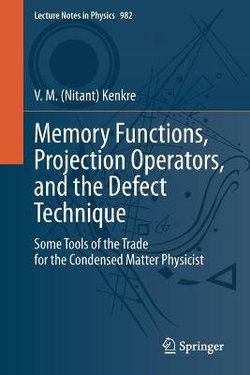Dedication page
Acknowledgments
Foreword
Authors' Preface
1 The Memory Function Formalism: What and Why
1.1 Introduction to Memory Functions1.2 An Example of How Memory Functions Arise: the Railway-Track Model
1.3 An Overview of Areas in which the Memory Formalism Helps
2 Zwanzig's Projection Operators: How They Yield Memories
2.1 The Derivation of the Master Equation: a Central Problem in Quantum Statistical Mechanics
2.2 Memories from Projection Operators that Diagonalize the Density Matrix
2.3 Two Simple Examples of Projections and an Exercise
2.3.1 Evolution of a Simple Complex Quantity2.3.2 Projection Operators for Quantum Control of Dynamic Localization
2.3.3 Exercise for the Reader: the Open Trimer
2.4 What is Missing from the Projection Derivation of the Master Equation
3 Building Coarse-Graining into the Projection Technique
3.1 The Need to Coarse-Grain
3.2 Constructing the Coarse-Graining Projection Operator
3.3 Generalization of the F orster-Dexter Theory of Excitation Transfer
3.4 Obtaining Realistic Memory Functions
3.5 Implementing a General Plan
3.5.1 Example in an Unrelated Area: Ferromagnetism
4 Features of Memory Functions and Relations to Other Entities
4.1 Resolution of the Perrin-F orster-Davydov Puzzle4.2 Relations Among Theories of Excitation Transfer
4.3 Long-range Transfer Rates as a Consequence of Strong Intersite Coupling
4.4 Connection of Memories to Neutron Scattering and Velocity Auto-Correlation Functions, and Pausing Time Distributions
5 Applications to Experiments: Transient Gratings, Ronchi Rulings, and Depolarization
5.1 Non-drastic Experiments: Fluorescence Depolarization as an Example
5.2 Ronchi Rulings for Measuring Coherence of Triplet Excitons
5.3 Fayer's Transient Gratings: an Ideal Experiment for Measuring Coherence of Singlet Excitons
6 Projection Operators for Various Contexts
6.1 Projections for the Theory of Electrical Resistivity
6.2 Projections that Integrate in Classical Systems
6.2.1 The BBGKY Hierarchy
6.2.2 Torrey-Bloch Equation for NMR Microscopy
6.3 Projections for Quantum Control of Dynamic Localization
6.4 Projections for the Railway-Track Model of Chapter 2
7 Memories and Projections in Nonlinear Equations of Motion
7.1 Extended Nonlinear Systems and the Physical Pendulum
7.2 Nonlinear Waves in Reaction Di_usion systems
7.3 Spatial Memories: Inuence Functions in the Fisher Equation
8 NMR Microsocopy and Granular Compaction
8.1 Pulsed Gradient NMR Signals in Con_ned Geometries
8.2 Analytic Solutions of a Generalized Torrey-Bloch Equation
8.3 Non-local Analysis of Stress Distribution in Compacted Sand
8.4 Spatial Memories and Correlations in the Theory of Granular Materials
9 Projections/Memories for Microscopic Treatment of Vibrational Relaxation
9.1 The Importance of Vibrational Relaxation
9.2 The Montroll-Shuler Equation and its Generalization to the Coherent Domain
9.3 Reservoir E_ects in Vibrational Relaxation
9.4 Approach to Equilibrium of a Simpler System: a Non-Degenerate Dimer
10 The Montroll Defect Technique
10.1 Introduction: Experiments that Modify Substantially
10.2 Overview of the Defect Technique and Simple Cases
10.2.1 Trapping at a Single Site
10.2.2 How Laplace Inversion may be avoided in Some Situations
10.2.3 Trapping at More than 1 Site: Exercise for the Reader
10.3 Coherence E_ects on Sensitized Luminescence
10.4 End-Detectors in a Simpson Geometry
10.5 High Defect Concentration: the _-fun



Share This Book: